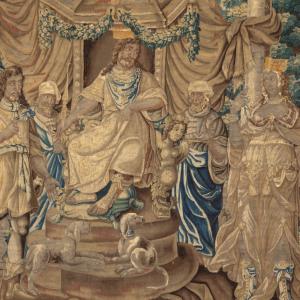Tapestry: Princely Marriage
Author: Unknown
Origin: Aubusson, France (?)
Dating: 17th century
Material: Wool & Silk
Dimensions (cm): 162 x 330
Inv. no.: PD0328
Multiple themes which were brought from Canonical literature – others, illustrating scenes from contemporary novels or themes taken from Mythology and Ancient History – were in demand for the decoration of new Bourgeoisie residencies. In a society in which reading was one of the favourite pastimes, people liked to surround themselves with decorations that reminded them of their Heroes. From the numerous subjects one may observe, one may quote some such as: The Story of Artemisia (a reigning Queen and the only female Captain in the Persian Navy during the invasion of Greece in the 5th century BC), Roland (a nephew of Charlemagne in the 8th century), The Faithful Shepherd, Marcus Antonius and Cleopatra, or the life of Paris and Helen (from the invasion of Troy by the Greeks and the story of Trojan Horse).
The characters are, in general, represented hierarchically with delightful naïve expressions, such as in this piece, in which (most likely) a Wedding is portrayed. It reminds us of the composition (although more elaborate and with another level of aesthetic performance) of Aubusson’s ‘Antoine mariant son fils Alexandre avec la fille du Roi de Médie’, from the General Council of Creuse.
In this object – which does not have the border that initially framed it and, thereby, added more decorative power to it – same characteristics may be found. The scene is unravelling in a view marked by the presence of a Throne made of hewn stone. The Throne is raised up on a structure with three steps and is framed by two columns in which the edges of the cloth come out of the central Canopy and cover the figure that is sitting down. This figure holds a sceptre in his right hand: a symbol of power. He has his feet resting on a cushion and is flanked by two male figures dressed in long garments. From his Royal place, he presides over a dialogue that is unravelling between the male and female figures who are, respectively, on the left and right of the Throne. The style and colours are of French manufacture, from the region of Marche.
Maria Antónia Quina









